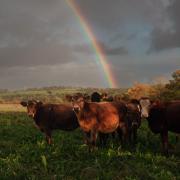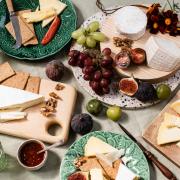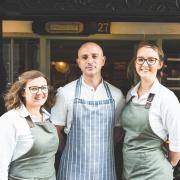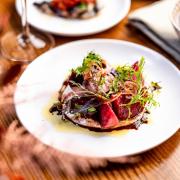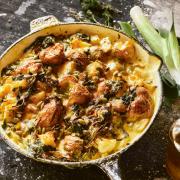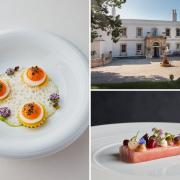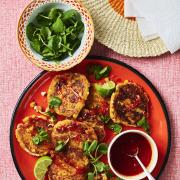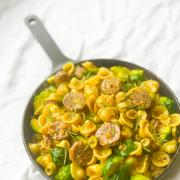Family traditions are so important for many, especially at Christmas, when food becomes a huge focus.
My grandma was German and every Christmas a package would arrive from Germany with stolen, marzipan and lebkuchen (delicious spiced biscuits coated in icing or chocolate). Lübeck Marzipan, coated in dark chocolate, was all I knew, I still absolutely love it! It’s not anything like the yellow marzipan you find in the shops here.
Christmas baking begins with the pudding which we would make at the beginning of December, along with mincemeat.
Christmas cake was another early bake in the run-up, covered in homemade marzipan and thick white royal icing, and topped with Father Christmas and his sleigh. My aunty was renowned for making the thickest jaw breaking royal icing!
This year I started making gifts for friends and family in October, cooking chutneys and preserves from the abundance of harvest. I appreciate more and more when gifts are made, we don’t need more ‘stuff’ which is also so heavily packaged.

Getting the Christmas tree was always an after-school treat at the end of term, and our decorations were used year after year. I still have many of them that I use now. A real tree brings such life into our homes, I wouldn't be without it. Before we moved to Devon from Hampshire three years ago, we had a tradition of picking and cutting our own tree from my friend's Christmas tree farm.
Here, we visited Ashburton Christmas Tree Farm which, on the edge of Dartmoor just outside of the town, is in a beautiful location.
I hope you have a wonderful run-up to Christmas this year.

Christmas Pudding recipe
If ever there was a recipe with a story or family history connected to it, it would certainly be the Christmas pudding.
My mum, as a child, used to go to Exmoor to visit a family friend in a village called Exford (I got married in this village because of this connection). She would visit Mrs Thorn and this recipe is hers. I have vivid memories of my mum making this recipe every year for Christmas when I was a child.
If you shy away from the usual heavy rich puddings, then this is for you. This pudding is quite the opposite. It is light in texture and colour. A few years ago it won a gold Great Taste award.
I am using cashew milk instead of dairy milk so the pudding is dairy free, do use dairy if you prefer. There is also a plant based egg alternative (see note)

Makes 1 x 2Ib or 2 x 1Ib puddings
Ingredients
75g currants
75g sultanas
75g raisins
75g candied peel
125g plain flour (I like to use a heritage grain flour)
100g dark muscovado sugar
200g suet
100g breadcrumbs
40g baking powder
135g milk (cashew or dairy)
65g whisky plus an additional 1-2 tbsp once cooked
2 eggs (*see note for alternative)
100g treacle
Method
Prepare your pudding bowl by greasing the inside, with oil or butter. Use a bowl with a lid which is ideal for cooking and storing the pudding in.
Put all the dry ingredients into a large mixing bowl and combine well.
In a separate bowl add the wet ingredients and use a whisk to mix together.
Add the wet into the dry ingredients and mix until there is no sign of any dry ingredients.
Put your mixture into your chosen bowl/bowls and secure with a lid. (As an alternative you can use a china bowl and cut a large square of greaseproof paper and foil to cover, allowing space to insert a crease. Have the greaseproof paper as the first layer which will touch the pudding. Secure with some string to keep them in place)
Find a pan big enough so the bowl fits with the pan lid on. Fill the pan with 1-2in of water.
Bring to the boil then turn down to a simmer. For the larger pudding steam for 3 hrs, for the smaller steam for 2 hrs.
Keep an eye on the water in the pan and top up if needed.
Once the pudding is cooked, remove from the pan onto a cooling rack. Remove the lid and using a large spoon pour the remaining whiskey on top. Replace the lid and store the pudding in a cool dark cupboard until Christmas.
On The Day
Re-steam your pudding before eating. For the smaller pudding allow 1 hour, for the larger 1 1⁄2 hours.
Turn the pudding onto a plate and remove the bowl, eat it straight away.
If you want to flambé the pudding, warm some brandy or whiskey in a pan, pour the warmed alcohol over the pudding and set it alight with a match.
*Plant based option. Combine 4 tbsp ground flax with 6 tbsp of water, let it sit for 5 minutes and add to your wet mix instead of eggs.

Mince Pies recipe
I have decided that mince pies need to start being made from the beginning of December. When Christmas arrives, we have so many other goodies to tickle our taste buds that the mince pies become an afterthought. These particular ones are definitely worth enjoying to the fullest throughout the season.
I have always gone to Elizabeth David's Christmas Book for her mincemeat recipe.
Mincemeat can be made as early as October, although making it in December is absolutely fine too.
These mince pies are plant-based because of the pastry. You will have leftover mincemeat to store and use in crumbles, fruit pies, and more mince pies.
Makes 18
For the mincemeat
750g coarsely chopped cored apples (I particularly like russet apples)
375g sultanas
375g currants
125g mixed peel
375g raisins
375g suet
60g whole almonds (coarsely chopped)
1 tsp each of ground nutmeg, cinnamon and mace
375g dark muscovado sugar
1 lemon (zest and juice)
1 orange (zest and juice)
150g brandy or rum
For the pastry
380g plain flour (I like to use an ancient grain flour, if it is wholewheat use 50/50 white and wholemeal)
250g coconut oil
110g cashew milk or other plant milk
1 tsp salt
Method
To make the mincemeat, combine all the ingredients together. Store the mixture in a sealed tub for the first few days and give it a good stir twice a day. Then, keep in a cool dark place in Kilner jars or similar until you are ready to use it.
Preheat the oven to 175C/Gas 4
Into a Magimix or similar, put the flour, salt and coconut oil. Mix until fine breadcrumbs form and add the cashew milk. Mix until the pastry comes together.
I have a baking tin which I love to use for my mince pies. It is a loose bottom non-stick muffin tin. But use whichever tin you have to hand which will make individual mince pies.
Keep your worktop and rolling pin well-floured. Roll out the dough to about 3mm thick. Remember to divide your pastry in two, use one half for the bases and the other half for the tops.
Depending on what tin you have chosen, find a round cutter approx 4cm bigger than the diameter of each hole.
I often cut a small slit about 2 cm into the side of each round as I find allowing for a small overlap will make it easier when lining the tins.
I like to use a star-shaped cutter for the tops.
Fill the lined tins with mincemeat, about ¾ full and top each one with a pastry star.
Placing a piece of greaseproof over the top of the tray, fixing it in place with some clips at either end will prevent any visible fruit burning.
Bake for half an hour until your pastry is light/golden brown and the mincemeat is bubbling.
Remove from the oven, and take the mince pies out of the tins straight away, otherwise they tend to stick.
Dust with icing sugar once cooled and keep in a sealed tub.
These last well for up to 2 weeks.

Christmas truffles recipe
These truffles are such a treat. They are very easy to make with simple ingredients. You can use them to create an indulgent treat for the end of a meal or they make a lovely gift.
What I love most about these truffles is that there are so many options for different flavours using essential oils. I have used peppermint in this particular recipe, but included suggestions for others that could be used.
Makes 40
Ingredients
270g dark chocolate sweetened with coconut sugar
120g coconut milk
60g maple syrup
50g cashew butter
⅛ tsp salt
8 drops peppermint oil
Cacao powder, to coat
Method
Place the chocolate and coconut milk in a bowl and using a whisk, melt the ingredients au bain marie. When everything is just melted, ensure your mixture is combined. Take off the heat once melted.
Repeat this process in anotehr bowl for the cashew butter and maple syrup.
Then add the cashew mix into the chocolate mix and combine.
Add the peppermint oil and the salt. Don’t overmix.
Pour into a tray lined with baking parchment to the depth you prefer. Choose your tin size accordingly.
Place in the fridge for a few hours or overnight.
Cutting the truffles
Pour boiling water in a flask and place a long sharp knife in it.
Cut the truffles to the size required with the hot knife, wiping it dry with a cloth before each cut. Between each cut dip the knife into the flask wiping it dry each time.
Put some cacao powder in a small shallow bowl and toss the truffles in it to coat evenly.
These truffles can be stored in a Kilner jar in the fridge for up to 1 week.
Tip:
It is always wonderful to experiment with the oils and see what pairs well with chocolate. Here are some of my favourites, with the amounts to use.
Lime, 8 drops
Cardamom, 8 drops
Wild orange, 12 drops
Geranium. 5 drops






